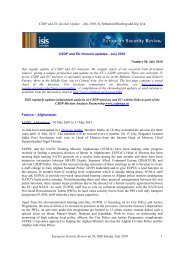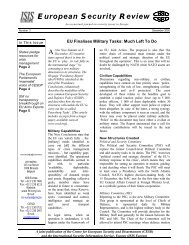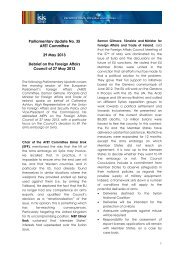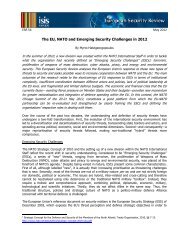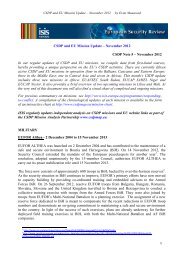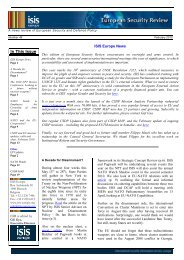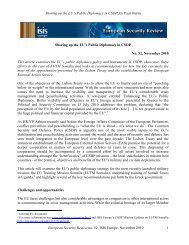the role of eu battlegroups for european defence - ISIS Europe
the role of eu battlegroups for european defence - ISIS Europe
the role of eu battlegroups for european defence - ISIS Europe
You also want an ePaper? Increase the reach of your titles
YUMPU automatically turns print PDFs into web optimized ePapers that Google loves.
The EU Battlegroups, by Myrto Hatzigeorgopoulos<br />
away from Brussels <strong>for</strong> 30 to 120 days. The structure <strong>of</strong> <strong>the</strong> <strong>battlegroups</strong> is not fixed, and <strong>the</strong>y can be<br />
tailored depending on <strong>the</strong> specific requirement <strong>of</strong> a mission via attaching maritime, air, logistical or o<strong>the</strong>r<br />
special enablers such as Special Forces. The contributing states set <strong>the</strong>mselves <strong>the</strong> goal <strong>of</strong> deploying on<br />
<strong>the</strong> ground within 10 days <strong>of</strong> an EU decision to launch an operation. Ei<strong>the</strong>r <strong>for</strong>med by a single EU<br />
Member State or by a so-called “framework state” with <strong>the</strong> support <strong>of</strong> contributing countries, it is<br />
commonly agreed that EU Battlegroups aim to achieve two goals: firstly, to enable rapid independent<br />
<strong>Europe</strong>an military response to crises, and secondly, to act as catalysts <strong>for</strong> <strong>the</strong> trans<strong>for</strong>mation <strong>of</strong> member<br />
states’ armed <strong>for</strong>ces and to increase cooperation and interoperability <strong>of</strong> <strong>Europe</strong>an national armies.<br />
Indeed, <strong>the</strong> 2003 <strong>Europe</strong>an Security Strategy (ESS) affirms that <strong>the</strong>re is a need “to trans<strong>for</strong>m our<br />
militaries into more flexible, mobile <strong>for</strong>ces and to enable <strong>the</strong>m to address <strong>the</strong> new threats”. 4<br />
Having originated after <strong>the</strong> prompt deployment <strong>of</strong> operation Artemis in June 2003, <strong>the</strong> EU BGs were<br />
initially meant to deploy upon <strong>for</strong>mal UN request, generally as a “bridging” or “initial entry <strong>for</strong>ce”.<br />
However, <strong>the</strong>ir scope has quickly been extended to autonomous rapid response operations and standalone<br />
operations to solve limited-size crises. The Battlegroup Concept stipulates that <strong>the</strong> units should be<br />
able to carry out <strong>the</strong> entire range <strong>of</strong> operations listed in <strong>the</strong> Petersberg tasks, and as complemented with<br />
those identified in <strong>the</strong> 2003 ESS (reviewed in 2008), ranging from humanitarian aid and peace<br />
en<strong>for</strong>cement operations to crisis management, assistance to security sector re<strong>for</strong>m and post-conflict<br />
stabilization. 5 Since BGs reached initial operational capability (IOC) in January 2005, a minimum <strong>of</strong> one<br />
BG has constantly been on standby <strong>for</strong> 6 months. The objective <strong>of</strong> <strong>the</strong> Battlegroups after reaching <strong>the</strong>ir<br />
full operational capability (FOC) was to enable <strong>the</strong> EU to undertake two concurrent single BG-sized rapid<br />
response operations, launched almost simultaneously.<br />
The costs and responsibility <strong>of</strong> planning, setting up, training, certifying, putting toge<strong>the</strong>r and making <strong>the</strong><br />
Battlegroups available to <strong>the</strong> EU lies with <strong>the</strong> troop-contributing nations, and primarily, with <strong>the</strong><br />
framework nation. The standard practices associated with military CSDP operations apply. The “common<br />
costs” related to <strong>the</strong> operational headquarters, local administration, transportation within <strong>the</strong> Operational<br />
Headquarters (OHQ) area, and lodging infrastructures are administered through <strong>the</strong> “A<strong>the</strong>na”<br />
mechanism. “Individual costs” (transport <strong>of</strong> troops from individual countries to <strong>the</strong> area <strong>of</strong> operations), as<br />
well as o<strong>the</strong>r costs linked to stand-up preparations and placing <strong>the</strong> EU BG on standby <strong>the</strong> responsibility <strong>of</strong><br />
contributing states according to <strong>the</strong> principle <strong>of</strong> “costs lie where <strong>the</strong>y fall”. 6 However, given <strong>the</strong> fact that<br />
costs jointly covered through A<strong>the</strong>na make up just 10% <strong>of</strong> <strong>the</strong> total maintenance and operational costs <strong>of</strong><br />
an EU BG, <strong>the</strong> bulk <strong>of</strong> <strong>the</strong> burden is provided by contributing nations, and especially by <strong>the</strong> framework<br />
nation, both in terms <strong>of</strong> cost-sharing and risk-sharing in case an operation is undertaken. 7 Consequently,<br />
many EU Member States have been prevented from taking <strong>the</strong> lead as framework nations, or even from<br />
playing a larger <strong>role</strong> in a BG <strong>for</strong>mation.<br />
Despite <strong>the</strong> initial political success <strong>of</strong> <strong>the</strong> BG Concept, Member States’ commitment to BGs seems to be<br />
currently experiencing a downturn. Indeed, five years after FOC was reached, not a single Battlegroup<br />
4 Gustav Lindstrom, «Enter <strong>the</strong> EU Battlegroups», Chaillot paper 97 (Feb. 2007), pp. 63-64<br />
5 «EU Battlegroups»,<br />
http://www.<strong>eu</strong>roparl.<strong>eu</strong>ropa.<strong>eu</strong>/meetdocs/2004_2009/documents/dv/<strong>eu</strong>_<strong>battlegroups</strong>_/<strong>eu</strong>_<strong>battlegroups</strong>_e<br />
n.pdf, p. 2<br />
6 Gustav Lindstrom, Ibid., pp. 25-26<br />
7 The Nordic BG is assumed to have cost Sweden more than 1.2 billion Swedish Krona (€130 million) during<br />
<strong>the</strong> first term <strong>of</strong> 2008, without having been used.<br />
<strong>ISIS</strong> EUROPE ESR 56 June 2012



